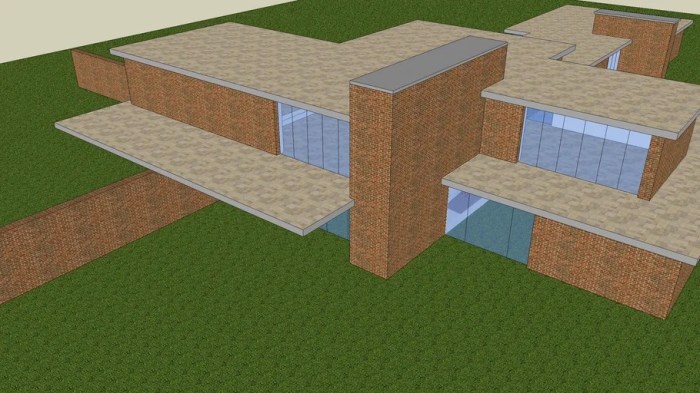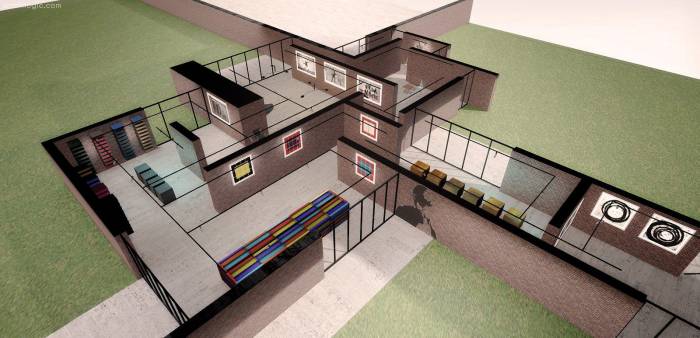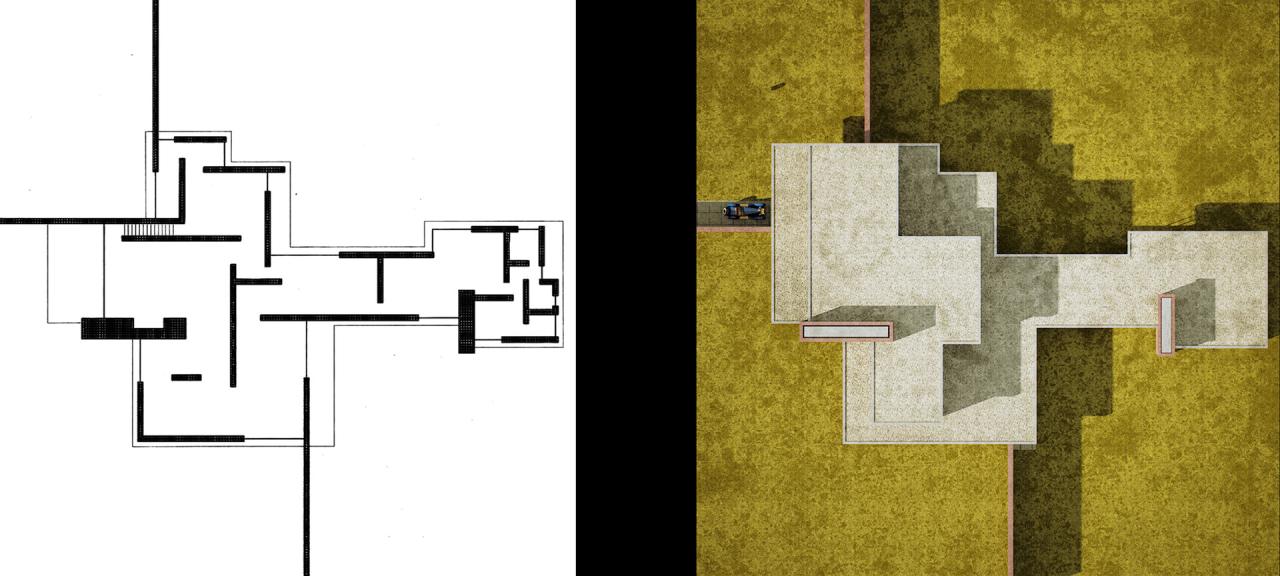Embark on a captivating journey into the realm of architecture with the iconic Brick House Mies van der Rohe. This remarkable residence embodies the essence of modernism, showcasing innovative design principles and groundbreaking construction techniques.
As we delve deeper into its history, significance, and influence, we’ll unravel the architectural genius behind this timeless masterpiece, leaving you with a profound appreciation for its enduring legacy.
Architectural Overview
Mies van der Rohe’s Brick House stands as a testament to his unwavering commitment to modernism and functionalism. Completed in 1932, this iconic residence exemplifies the architect’s belief in the simplicity of form and the honest expression of materials.
The Brick House is a single-story structure characterized by its clean lines, geometric forms, and minimalist aesthetic. Its rectangular plan is divided into two distinct zones: a living area and a sleeping area. The living area features an open floor plan with a fireplace as its focal point, while the sleeping area consists of two bedrooms and a bathroom.
Key Features and Design Principles
- Emphasis on Horizontality:The Brick House is designed with a low profile and horizontal lines that emphasize its connection to the surrounding landscape.
- Open Floor Plan:The living area is characterized by an open floor plan that creates a sense of spaciousness and allows for a seamless flow of movement.
- Integration of Indoor and Outdoor Spaces:Large windows and sliding glass doors connect the interior to the exterior, blurring the boundaries between the two.
Innovative Use of Materials and Construction Techniques
The Brick House showcases Mies van der Rohe’s innovative use of materials and construction techniques.
- Brick Construction:The exterior walls are constructed of red brick, a material that Mies van der Rohe chose for its durability and aesthetic appeal.
- Steel Frame:The house is supported by a steel frame, which allowed for the creation of large, open spaces without the need for load-bearing walls.
- Flat Roof:The Brick House features a flat roof, which was a departure from traditional pitched roofs and further emphasized its modernist aesthetic.
Historical Context
The Brick House, designed by Ludwig Mies van der Rohe, emerged during a pivotal period in architectural history. It was conceived in the 1920s, a time marked by profound social and technological transformations.
The Bauhaus movement, founded by Walter Gropius in 1919, exerted a profound influence on the architectural landscape of the era. This movement advocated for a functionalist approach to design, emphasizing simplicity, geometric forms, and the integration of art and technology.
Bauhaus Influence
Mies van der Rohe’s Brick House embodies many of the principles espoused by the Bauhaus. Its rectilinear form, unadorned facade, and open floor plan reflect the Bauhaus’s emphasis on clarity, functionality, and the blurring of boundaries between interior and exterior spaces.
The house’s use of brick as a primary building material also aligns with the Bauhaus’s preference for honest and straightforward materials that celebrate their inherent qualities.
Spatial Analysis

The Brick House exhibits a thoughtful spatial organization that enhances its functionality and blurs the boundaries between interior and exterior spaces.
The open floor plan allows for fluid movement throughout the house, creating a sense of spaciousness and interconnectedness. The living, dining, and kitchen areas seamlessly flow into one another, fostering a sense of community and facilitating social interaction.
Interior-Exterior Relationship
The house’s relationship with its surroundings is carefully considered. Large windows and sliding glass doors provide ample natural light and offer stunning views of the lush garden. The transition between indoor and outdoor spaces is effortless, extending the living area into the garden and creating a harmonious relationship between architecture and nature.
Materiality and Construction: Brick House Mies Van Der Rohe

The Brick House showcases a masterful interplay of materials, reflecting Mies van der Rohe’s commitment to functionalism and aesthetic simplicity.
The exterior facade is clad in red brick, creating a striking visual presence. The bricks are laid in a running bond pattern, emphasizing the horizontal lines and enhancing the building’s sense of solidity. The brick facade not only provides durability but also serves as a thermal mass, regulating the interior temperature and creating a comfortable living environment.
Innovative Use of Steel and Glass
Mies van der Rohe’s innovative use of steel and glass is evident in the house’s structural and architectural elements. Steel beams and columns support the building’s roof and walls, allowing for open and flexible interior spaces. The extensive use of glass, particularly in the living room’s floor-to-ceiling windows, blurs the boundaries between interior and exterior, creating a sense of transparency and spaciousness.
The brick house designed by Mies van der Rohe stands as a testament to minimalist architecture, with its clean lines and open spaces. This approach to design has influenced numerous architects, including Angel B. Perez. As Perez states in his article “Learn to Fail,” the ability to embrace failure is crucial for growth.
This principle can be applied to architecture, where experimentation and risk-taking can lead to innovative designs like Mies van der Rohe’s brick house.
Architectural Details

The Brick House showcases meticulous attention to detail, with each element contributing to its overall aesthetic and functionality.The large window frames, made of dark-stained wood, provide ample natural light while framing views of the surrounding landscape. The door handles and other hardware, also in dark wood, are simple yet elegant, complementing the home’s minimalist design.The
interplay of natural light and shadow is a key feature of the Brick House. The large windows allow abundant sunlight to penetrate the interior, creating a bright and airy atmosphere. The strategic placement of windows and skylights ensures that natural light reaches even the darkest corners of the house.
Conversely, the deep overhangs and recessed balconies create areas of shadow, providing contrast and depth to the facade.
Landscape and Environment
The Brick House is situated on a sloping, wooded lot in suburban Chicago. The house is surrounded by mature trees, which provide shade and privacy. The lot is also home to a variety of native plants and flowers, which attract birds and other wildlife.
The house is designed to interact with its natural surroundings in a number of ways. The large windows on the south and east sides of the house allow natural light to flood the interior spaces. The windows also provide views of the surrounding landscape, which helps to create a sense of connection between the inside and outside.
Relationship to Urban Context
The Brick House is located in a quiet residential neighborhood. The house is set back from the street, which helps to create a sense of privacy. The house is also surrounded by other single-family homes, which creates a sense of community.
The Brick House is a significant example of modern architecture. The house is a testament to Mies van der Rohe’s commitment to simplicity, functionality, and elegance.
Cultural Impact

The Brick House by Mies van der Rohe has had a profound cultural impact, influencing subsequent architectural movements and solidifying its status as a landmark and architectural icon.The Brick House epitomizes the modernist principles of simplicity, clarity, and functionality. Its open floor plan, unadorned brick exterior, and emphasis on natural light revolutionized residential architecture.
It challenged traditional notions of domesticity, promoting a more fluid and flexible living space that catered to the changing needs of modern families.
Influence on Architectural Movements
The Brick House served as a catalyst for the development of modernism in architecture. Its innovative design inspired a generation of architects, who adopted its principles and sought to create buildings that were both functional and aesthetically pleasing. The influence of the Brick House can be seen in the works of architects such as Le Corbusier, Walter Gropius, and Alvar Aalto.
Significance as a Landmark and Architectural Icon, Brick house mies van der rohe
The Brick House has become a symbol of modern architecture and is widely recognized as a landmark. Its distinctive appearance and historical significance have made it a popular destination for tourists and architecture enthusiasts. The house has been featured in numerous publications and exhibitions, further solidifying its status as an architectural icon.
Detailed FAQs
What is the architectural significance of the Brick House Mies van der Rohe?
It exemplifies the principles of modernism, showcasing innovative use of materials, open floor plans, and fluid spaces, while seamlessly blending interior and exterior environments.
How did the Bauhaus movement influence the design of the Brick House?
The Bauhaus emphasis on simplicity, functionality, and geometric forms is evident throughout the house, from its clean lines to its minimalist detailing.
What materials were used in the construction of the Brick House?
The exterior features a distinctive brick facade, while the interior boasts steel and glass elements, creating a harmonious blend of traditional and modern materials.